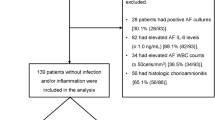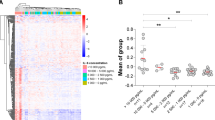Abstract
Preterm labor (PTL) is frequently associated with inflammation. We hypothesized that biomarkers during pregnancy can identify pregnancies most at risk for development of PTL. An inflammation-induced mouse model of PTL was used. Surface-enhanced laser desorption/ionization time-of-flight mass spectrometry was used to analyze and compare the plasma protein (PP) profile between CD-1 mice injected intrauterine with either lipopolysaccharide (LPS) or PBS on d 14.5 of gestation. The median differences of normalized PP peaks between the two groups were determined using the Mann-Whitney U test and the false discovery rate. In a second series of experiments, both groups of mice were injected with a lower dose of LPS. A total of 1665 peaks were detected. Thirty peaks were highly differentially expressed (p < 0.0001) between the groups. Two 11 kDa protein peaks were identified by MALDI-TOF/TOF-MS and confirmed to be mouse serum amyloid A (SAA) 1 and 2. Plasma SAA2 levels were increased in LPS-treated animals compared with controls and in LPS-treated animals that delivered preterm vs. those that delivered at term. SAA2 has the potential to be a plasma biomarker that can identify pregnancies at risk for development of PTL.
Similar content being viewed by others
Log in or create a free account to read this content
Gain free access to this article, as well as selected content from this journal and more on nature.com
or
Abbreviations
- ACN:
-
acetonitrile
- FDR:
-
false discovery rate
- IU:
-
intrauterine
- LPS:
-
lipopolysaccharide
- MW:
-
Mann-Whitney
- PTL:
-
preterm labor
- SAA:
-
serum amyloid A
- SELDI-TOF/MS:
-
surface-enhanced laser desorption/ionization time-of-flight mass spectrometry
- TFA:
-
trifluoroacetic acid
References
Slattery MM, Morrison JJ 2002 Preterm delivery. Lancet 360: 1489–1497
Lemons JA, Bauer CR, Oh W, Korones SB, Papile LA, Stoll BJ, Verter J, Temprosa M, Wright LL, Ehrenkranz RA, Fanaroff AA, Stark A, Carlo W, Tyson JE, Donovan EF, Shankaran S, Stevenson DK 2001 Very low birth weight outcomes of the National Institute of Child health and human development neonatal research network, January 1995 through December 1996. NICHD Neonatal Research Network. Pediatrics 107: E1
Goldenberg RL, Hauth JC, Andrews WW 2000 Intrauterine infection and preterm delivery. N Engl J Med 342: 1500–1507
Simhan HN, Caritis SN 2007 Prevention of preterm delivery. N Engl J Med 357: 477–487
Smith R 2007 Parturition. N Engl J Med 356: 271–283
Meis PJ, Klebanoff M, Thom E, Dombrowski MP, Sibai B, Moawad AH, Spong CY, Hauth JC, Miodovnik M, Varner MW, Leveno KJ, Caritis SN, Iams JD, Wapner RJ, Conway D, O'Sullivan MJ, Carpenter M, Mercer B, Ramin SM, Thorp JM, Peaceman AM, Gabbe S 2003 Prevention of recurrent preterm delivery by 17 alpha-hydroxyprogesterone caproate. N Engl J Med 348: 2379–2385
Fonseca EB, Celik E, Parra M, Singh M, Nicolaides KH 2007 Progesterone and the risk of preterm birth among women with a short cervix. N Engl J Med 357: 462–469
Goldenberg RL, Goepfert AR, Ramsey PS 2005 Biochemical markers for the prediction of preterm birth. Am J Obstet Gynecol 192: S36–S46
Goldenberg RL, Culhane JF 2003 Infection as a cause of preterm birth. Clin Perinatol 30: 677–700
Goncalves LF, Chaiworapongsa T, Romero R 2002 Intrauterine infection and prematurity. Ment Retard Dev Disabil Res Rev 8: 3–13
Christiaens I, Zaragoza DB, Guilbert L, Robertson SA, Mitchell BF, Olson DM 2008 Inflammatory processes in preterm and term parturition. J Reprod Immunol 79: 50–57
Pennell CE, Jacobsson B, Williams SM, Buus RM, Muglia LJ, Dolan SM, Morken NH, Ozcelik H, Lye SJ, Relton C 2007 Genetic epidemiologic studies of preterm birth: guidelines for research. Am J Obstet Gynecol 196: 107–118
Gibbs RS, Romero R, Hillier SL, Eschenbach DA, Sweet RL 1992 A review of premature birth and subclinical infection. Am J Obstet Gynecol 166: 1515–1528
Petricoin EF, Ardekani AM, Hitt BA, Levine PJ, Fusaro VA, Steinberg SM, Mills GB, Simone C, Fishman DA, Kohn EC, Liotta LA 2002 Use of proteomic patterns in serum to identify ovarian cancer. Lancet 359: 572–577
Basso D, Valerio A, Seraglia R, Mazza S, Piva MG, Greco E, Fogar P, Gallo N, Pedrazzoli S, Tiengo A, Plebani M 2002 Putative pancreatic cancer-associated diabetogenic factor: 2030 MW peptide. Pancreas 24: 8–14
Yasui Y, Pepe M, Thompson ML, Adam BL, Wright GL Jr, Qu Y, Potter JD, Winget M, Thornquist M, Feng Z 2003 A data-analytic strategy for protein biomarker discovery: profiling of high-dimensional proteomic data for cancer detection. Biostatistics 4: 449–463
Clarke W, Silverman BC, Zhang Z, Chan DW, Klein AS, Molmenti EP 2003 Characterization of renal allograft rejection by urinary proteomic analysis. Ann Surg 237: 660–664; discussion 664–665.
Poon TC, Hui AY, Chan HL, Ang IL, Chow SM, Wong N, Sung JJ 2005 Prediction of liver fibrosis and cirrhosis in chronic hepatitis B infection by serum proteomic fingerprinting: a pilot study. Clin Chem 51: 328–335
Conrads TP, Fusaro VA, Ross S, Johann D, Rajapakse V, Hitt BA, Steinberg SM, Kohn EC, Fishman DA, Whitely G, Barrett JC, Liotta LA, Petricoin EF III, Veenstra TD 2004 High-resolution serum proteomic features for ovarian cancer detection. Endocr Relat Cancer 11: 163–178
Rubin RB, Merchant M 2000 A rapid protein profiling system that speeds study of cancer and other diseases. Am Clin Lab 19: 28–29
Wagner M, Naik DN, Pothen A, Kasukurti S, Devineni RR, Adam BL, Semmes OJ, Wright GL Jr 2004 Computational protein biomarker prediction: a case study for prostate cancer. BMC Bioinformatics 5: 26
Gravett MG, Novy MJ, Rosenfeld RG, Reddy AP, Jacob T, Turner M, McCormack A, Lapidus JA, Hitti J, Eschenbach DA, Roberts CT Jr, Nagalla SR 2004 Diagnosis of intra-amniotic infection by proteomic profiling and identification of novel biomarkers. JAMA 292: 462–469
Elovitz MA, Wang Z, Chien EK, Rychlik DF, Phillippe M 2003 A new model for inflammation-induced preterm birth: the role of platelet-activating factor and Toll-like receptor-4. Am J Pathol 163: 2103–2111
Madan A, El-Ferzli G, Carlson SM, Whitin JC, Schilling J, Najmi A, Yu TT, Lau K, Dimmitt RA, Cohen HJ 2007 A potential biomarker in the cord blood of preterm infants who develop retinopathy of prematurity. Pediatr Res 61: 215–221
Benjamini Y, Hochberg Y 1995 Controlling the false discovery rate: a practical and powerful approach to multiple testing. J Roy Statist Soc Ser B 57: 289–300
Tusher VG, Tibshirani R, Chu G 2001 Significance analysis of microarrays applied to the ionizing radiation response. Proc Natl Acad Sci USA 98: 5116–5121
Efron B, Tibshirani R 2002 Empirical Bayes methods and false discovery rates for microarrays. Genet Epidemiol 23: 70–86
Aubert J, Bar-Hen A, Daudin JJ, Robin S 2004 Determination of the differentially expressed genes in microarray experiments using local FDR. BMC Bioinformatics 5: 125
Galvani M, Bordini E, Piubelli C, Hamdan M 2000 Effect of experimental conditions on the analysis of sodium dodecyl sulphate polyacrylamide gel electrophoresis separated proteins by matrix-assisted laser desorption/ionisation mass spectrometry. Rapid Commun Mass Spectrom 14: 18–25
Hamdan M, Galvani M, Righetti PG 2001 Monitoring 2-D gel-induced modifications of proteins by MALDI-TOF mass spectrometry. Mass Spectrom Rev 20: 121–141
Le L, Chi K, Tyldesley S, Flibotte S, Diamond DL, Kuzyk MA, Sadar MD 2005 Identification of serum amyloid A as a biomarker to distinguish prostate cancer patients with bone lesions. Clin Chem 51: 695–707
Li Y, Dang TA, Shen J, Perlaky L, Hicks J, Murray J, Meyer W, Chintagumpala M, Lau CC, Man TK 2006 Identification of a plasma proteomic signature to distinguish pediatric osteosarcoma from benign osteochondroma. Proteomics 6: 3426–3435
Moshkovskii SA, Serebryakova MV, Kuteykin-Teplyakov KB, Tikhonova OV, Goufman EI, Zgoda VG, Taranets IN, Makarov OV, Archakov AI 2005 Ovarian cancer marker of 11.7 kDa detected by proteomics is a serum amyloid A1. Proteomics 5: 3790–3797
Uhlar CM, Whitehead AS 1999 Serum amyloid A, the major vertebrate acute-phase reactant. Eur J Biochem 265: 501–523
Urieli-Shoval S, Cohen P, Eisenberg S, Matzner Y 1998 Widespread expression of serum amyloid A in histologically normal human tissues. Predominant localization to the epithelium. J Histochem Cytochem 46: 1377–1384
O'Hara R, Murphy EP, Whitehead AS, FitzGerald O, Bresnihan B 2000 Acute-phase serum amyloid A production by rheumatoid arthritis synovial tissue. Arthritis Res 2: 142–144
Meek RL, Urieli-Shoval S, Benditt EP 1994 Expression of apolipoprotein serum amyloid A mRNA in human atherosclerotic lesions and cultured vascular cells: implications for serum amyloid A function. Proc Natl Acad Sci USA 91: 3186–3190
Vlasova MA, Moshkovskii SA 2006 Molecular interactions of acute phase serum amyloid A: possible involvement in carcinogenesis. Biochemistry (Mosc) 71: 1051–1059
Kovacevic A, Hammer A, Sundl M, Pfister B, Hrzenjak A, Ray A, Ray BK, Sattler W, Malle E 2006 Expression of serum amyloid A transcripts in human trophoblast and fetal-derived trophoblast-like choriocarcinoma cells. FEBS Lett 580: 161–167
Baggia S, Gravett MG, Witkin SS, Haluska GJ, Novy MJ 1996 Interleukin-1 beta intra-amniotic infusion induces tumor necrosis factor-alpha, prostaglandin production, and preterm contractions in pregnant rhesus monkeys. J Soc Gynecol Investig 3: 121–126
Brown NL, Alvi SA, Elder MG, Bennett PR, Sullivan MH 1998 A spontaneous induction of fetal membrane prostaglandin production precedes clinical labour. J Endocrinol 157: R1–R6
Hagihara K, Nishikawa T, Isobe T, Song J, Sugamata Y, Yoshizaki K 2004 IL-6 plays a critical role in the synergistic induction of human serum amyloid A (SAA) gene when stimulated with proinflammatory cytokines as analyzed with an SAA isoform real-time quantitative RT-PCR assay system. Biochem Biophys Res Commun 314: 363–369
Badolato R, Wang JM, Murphy WJ, Lloyd AR, Michiel DF, Bausserman LL, Kelvin DJ, Oppenheim JJ 1994 Serum amyloid A is a chemoattractant: induction of migration, adhesion, and tissue infiltration of monocytes and polymorphonuclear leukocytes. J Exp Med 180: 203–209
Patel H, Fellowes R, Coade S, Woo P 1998 Human serum amyloid A has cytokine-like properties. Scand J Immunol 48: 410–418
Lee HY, Kim MK, Park KS, Bae YH, Yun J, Park JI, Kwak JY, Bae YS 2005 Serum amyloid A stimulates matrix-metalloproteinase-9 upregulation via formyl peptide receptor like-1-mediated signaling in human monocytic cells. Biochem Biophys Res Commun 330: 989–998
Takeda K, Akira S 2003 Toll receptors and pathogen resistance. Cell Microbiol 5: 143–153
Engin-Ustun Y, Ustun Y, Karabulut AB, Ozkaplan E, Meydanli MM, Kafkasli A 2007 Serum amyloid A levels are increased in pre-eclampsia. Gynecol Obstet Invest 64: 117–120
Author information
Authors and Affiliations
Corresponding author
Additional information
Supported by the Hess (A.M.), Euphrates (H.J.C.), and Pediatric Research Funds (A.M.).
Rights and permissions
About this article
Cite this article
Yang, Q., Whitin, J., Ling, X. et al. Plasma Biomarkers in a Mouse Model of Preterm Labor. Pediatr Res 66, 11–16 (2009). https://doi.org/10.1203/PDR.0b013e3181a207e3
Received:
Accepted:
Issue date:
DOI: https://doi.org/10.1203/PDR.0b013e3181a207e3
This article is cited by
-
Serum amyloid A – a review
Molecular Medicine (2018)
-
Induction of pro-inflammatory genes by serum amyloid A1 in human amnion fibroblasts
Scientific Reports (2017)
-
Identifying technical aliases in SELDI mass spectra of complex mixtures of proteins
BMC Research Notes (2013)



